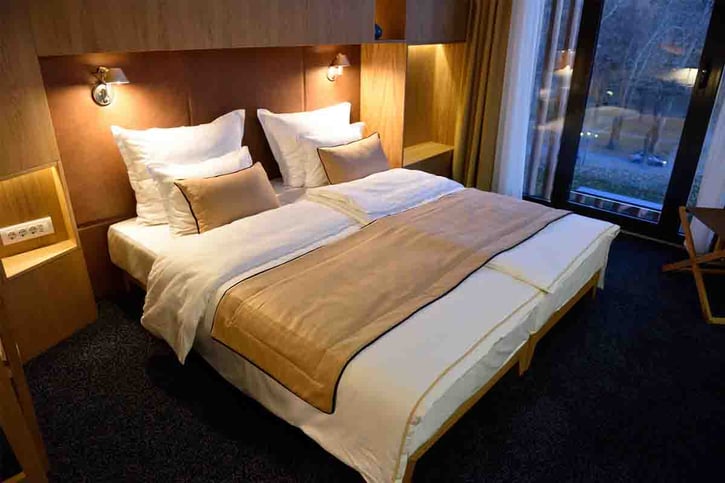
Our bodies are very complex structures, and turning all of it off for sleep requires effort. In short, we actually have to work at getting rest, and the key to getting there faster has been the challenge that the sleep industry has worked towards solving ever since their inception.
There are plenty of factors that can help or prevent you from getting good sleep - diet, sleeping issues, psychological state - and each industry tries to solve this problem in their own way. One common solution is simply affecting the temperature of the sleeper when they fall asleep, but this isn’t as easy as you may think.
The optimal humidity for your house is 40~60%. Therefore, its best to keep your living room, bedroom, and stairways around this humidity level. However, your kitchen and bathroom tends to release more moisture and its best to keep the humidity around 50~70%.
Controlling your environment’s temperature and humidity is a more sustainable way to sleep better. Apart from working on your personal health and diet, you can also balance it with creating an environment where your body is most comfortable. Being aware of these different factors can help you pinpoint what needs to be improved and make the necessary adjustments.
How different humidity levels affect your sleep
When you go to sleep, you enter three non-rapid eye movement (NREM) stages and one rapid eye movement stage (REM). The first three NREM stages prepare your body for a deep sleep, eventually leading you to REM. During the NREM stages, your body’s temperature decreases, heart and breathing rate slows, and your body begins to repair itself.
When you enter deep sleep, your breathing rate and brain activity increase. As its name suggests, your eyes will also begin to move rapidly, causing you to dream. This stage is necessary for memory consolidation and total rest.
If you were to sleep in a humid room, your sleep cycle can be gravely affected. Since your body is not able to regulate your temperature during your deep sleep stage, your body will allocate more energy to keep your body warm. In effect, your deep sleep stages will be shorter and you are more likely to wake up in the middle of the night from discomfort. Since sleep plays a big role in your holistic health, shorter sleep means more vulnerability to sickness.
A more humid room can also trigger allergies. Because mold thrives in humid environments, you are more likely to develop bronchitis, respiratory infections, and other breathing problems that can cause sleep disruptions. Sometimes, it can also cause people to sweat excessively.
On the other end of the spectrum, low humidity can also cause sore throat and respiratory infection. You are also more likely to wake up with dry skin and itchy eyes.
Best humidity level for your home and bedroom
Relative humidity (RH) is a standard way to measure humidity. The best way to measure room humidity is with the use of a hygrometer. Here is the way to measure relative humidity level in your home.
If there is a natural wind or a breeze in a high humidity climate, even if the temperature is not particularly low, the apparent temperature is often lower than the actual temperature. For example, the mobile device displays a temperature of 8 degrees and the humidity is 81%, but the apparent temperature is actually only 3 degrees. In this case, you need to stay warm.
Research shows that 40% ~ 60% humidity is ideal for indoors. Most experts agree that going above 60% is too humid for the human lungs to cope with. During winter times, it is usually difficult to keep the air this moist. Most people do keep their room humidity at around 40% - 50% and that's usually the average comfort zone.
According to experts, the ideal room humidity level for better sleep is between 30% ~ 50%. This means being in an environment that is too dry, or has too much moisture can impact the quality of our sleep.
First of all, if the environment is too humid, the moisture within your body will be harder to evaporate. This will make you hot, and stuffy, making it harder for us to sleep comfortably. For those who have allergies, a humid environment will also accelerate mold growth. This might make your allergy worse and affect your sleep at night.
Then comes the problem of being too dry. When your skin and breathing system gets too dry, you might get itchy throats or catch a cold. When you feel itchy, sick and irritated, you won't be able to sleep well.
How to facilitate optimal humidity in your bedroom
Knowing that your room’s relative humidity should lie within the 40% - 60% range, there are many ways to maintain moderate humidity.
- Invest in the right kind of air conditioning system. Studies show that people sleep better when using the machine’s moderate settings. Once you fall asleep, your body will eventually adjust to lower temperatures. Cranking up your unit’s speed can decrease your room’s humidity, but the colder air will also increase your discomfort and your heart rate.
- Get a dehumidifier for your room. Opposite to humidifiers, dehumidifiers use a fan to collect moisture from the air and store it in its internal tank. These machines come in different portable sizes. If you are interested, however, in keeping your entire home free of extra vapor, there are whole-house models that can be integrated into your HVAC system. Whatever size you may be getting, it is important to clean out its filters and empty its internal tanks of water.
- Cotton and rayon bed sheets are your best friends. Synthetic materials are not as breathable as its more natural counterpart, trapping sweat and moisture on your skin’s surface. Using cotton and rayon are breathable, ensuring that you don’t wake up from night sweats.
- Look for a more breathable alternative to your memory foam mattress. Because of the way these mattresses are designed to relieve certain muscles or joints from pressure and isolate your movement, its layers can trap heat and can cause you to feel warm. If your mattresses are not prescribed by your doctor, we recommend going for a latex mattress for its breathable and ventilated layers
- Invest in a high-ventilated electric blanket. An electric blanket is a great way to keep you warm during winter times. With the right electric blanket, you don’t have to turn the heater on too high as it might make the room stuffy and humid. Remember it is important to buy an electric blanket made with breathable fabrics to keep you warm and comfortable at night.
Best temperature for sleeping in Celsius
The best temperature for sleeping is around 16~18 degrees celsius (60.8~64.4°F). However, 18.5°C ~ 20.5°C is an ideal house temperature range for your room. Everyone's sense is a bit different and you should choose a temperature that makes you most comfortable. Keeping the temperature a bit higher also saves your home's electricity!
This is the normal temperature our circadian rhythm (the 24 hour process or cycle our body physically goes through) in order to get to sleep. But plenty of factors can affect this: our environment, our physical activity before rest, and even the food we eat can all play a role in how easily or how hard it is for us to rest.
Falling asleep 101
Our body cools down when we begin to drift off to sleep - it’s this process that usually indicates to our systems that it’s time to rest. For people with lower or higher than average body temperatures like athletes or those used to an extreme climate, getting to this point can be difficult.
Sleep aids and products aim to help people reach this point faster - and none of the products are as common and as accessible as the heating blanket. Simple and easy to use, it’s been a common tool for people to use in order to help themselves get to sleep more comfortably.
So what seems to be the issue?
Heating and 4D DWF
The primary purpose of heating blankets is to introduce heat - but the earliest models also had trouble getting rid of it, or introducing the right kind of heat. Without a way to control humidity, the air inside the blanket became hot and arid, often causing troubles as often as they would clear them.
The primary issue was dry air: the air that comes when the blanket doesn’t have enough breathability. You couldn’t use them for too long as you’d feel stuffy from all the heat, and the heat generated from the blanket would mix with your own body heat in response, finally forcing you to kick off the blanket - which would mean the resulting temperature change would shock your body awake, or straight into a cold the next day.
However, Wellcare’s innovation in heating blankets seeks to change all that. With a design focused on creating the sleeper’s own climate when they are at rest, we’ve developed the 4-Dimensional Dynamic Warmth Flow technology and integrated it with our heating blankets. Efficient at heating, but at the same time allow humidity from outside the blanket allow our products to help you get to sleep far better.
4D DWF provides exceptional breathability to maintain the optimal sleep temperature and humidity level throughout the night. You no longer have to worry about waking up in the middle of the night because you're too hot or too cold.
4D DWF technology disperses the heat generated by our blankets through uniquely designed holes, allowing them to give you ideal conditions for sufficient and comfortable sleep.
Interested in the capabilities of the 4D DWF technology and what it can do for your sleep? Look into our products here, or contact Wellcare via our link below!
References:
https://www.entrepreneur.com/article/248030
https://sleep.org/articles/humidity-and-sleep/
http://www.huffingtonpost.com/jackie-stroka/what-are-the-trends-in-th_b_8268566.html
https://academic.oup.com/ageing/article/43/4/571/2812220


.png?width=512&name=united-kingdom%20(1).png)

